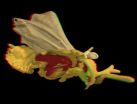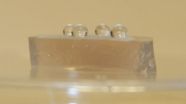VIB-K.U. Leuven scientists clear the way to alternative anti-angiogenic cancer therapy
2011-01-08
(Press-News.org) Leuven – Scientists attached to VIB and K.U.Leuven have succeeded in decoding a potential new anti-cancer mechanism. The researchers discovered that normalizing abnormal tumor blood vessels through HRG (histidine-rich glycoprotein) prevents metastasis of tumor cells and enhances chemotherapy efficiency. In tumors, vessels formation is disturbed, leading to inefficient delivery of chemotherapeutic drugs and allowing cancer cells to escape to other parts of the body (metastasis). The normalization of tumor blood vessel formation through HRG works by repressing the production of the Placental Growth Factor PlGF. Anti-PlGF therapy is now being tested as a new agent against cancer by ThromboGenics in collaboration with Roche. The recently discovered mechanism offers alternative possibilities for cancer treatment.
Cancer and the formation of blood vessels (angiogenesis)
Every growing tissue is supplied with oxygen and nutrients through our blood vessels. However, tumors grow much faster than normal tissue and have a higher need for nutrients. Consequently, tumor cells start generating growth factors to stimulate the growth of new blood vessels. However, the resulting blood vessels are of abnormal shape, causing poor blood flow and little oxygen supply to the cancer cells. The oxygen shortage encourages cancer metastasis and eventually leads to a malignant cancer. Furthermore, the abnormal shape of the blood vessels hampers the supply and efficiency of anti-cancer drugs.
Conventional anti-angiogenic therapy
Conventional anti-angiogenic cancer therapy in which a growth factor is eliminated may aggravate tumor metastasis, becase. Because of this, there has in recent years been a greater focus on anti-angiogenic therapies which normalize the blood vessels supplying the tumor. This would reduce the oxygen shortage, with the result that the cancer cells will tend to travel less to other parts of the body and anti-cancer drugs can be delivered more efficiently.
Histidine-rich glycoprotein (HRG)
Charlotte Rolny, Max Mazzone and their colleagues from the VIB Vesalius Research Center, K.U.Leuven, have under the direction of Peter Carmeliet and in collaboration with VIB researchers from the Vrije Universiteit Brussel and colleagues from Sweden studied the mechanism behind the known anti-cancer activity of the protein HRG. The results of their experiments show that HRG, a protein distributed in the tumor stroma, displays anti-cancer activity by combating tumor progression and spread and stimulating normalization of tumor blood vessels. The underlying basis of this action is the capacity of HRG to suppress the angiogenic factor PlGF.
Towards an alternative cancer therapy
Revealing the mechanism behind the anti-cancer activity of HRG opens up new horizons for cancer treatment. The larger a tumor becomes, the higher its oxygen requirement. However, the tumor vessels that are formed are abnormal in shape, leading to poor blood and oxygen flow. This oxygen shortage stimulates cancer cell metastasis. Stimulating HRG in the tumor stroma counters tumor progression and spread while at the same time being conducive to normalization of tumor blood vessels which enhances the efficacy of chemotherapy. Moreover, these data also support eliminating PlGF for the treatment of cancer.
INFORMATION:
END
ELSE PRESS RELEASES FROM THIS DATE:
2011-01-08
When interviewed by the BBC, the now retired BP boss Tony Hayward admitted to his company's insufficient response to the Deepwater Horizon rig accident in the Gulf of Mexico. Could the company have been better prepared for what turned out to be one of the biggest oil disasters in history?
"We were making it up day to day," Hayward said of BP's rescue plan. Together with chairman of the board, Carl-Henrik Svenberg, he was held responsible for 11 dead and 17 injured workers. According to the New York Times, five million barrels of oil leaked into the ocean outside the coast ...
2011-01-08
Its stay on this planet was actually meant to be a very short one. Male twisted-wing parasites (Strepsiptera) usually have a life span of only few hours. However, accidentally a specimen of Mengea tertiara, about the size of an aphid, became preserved for 'eternity': during its wedding flight about 42 million years ago it was caught in a drop of tree resin and subsequently almost perfectly conserved in a piece of amber.
PD Dr. Hans Pohl of Friedrich Schiller University Jena (Germany) calls this "a very exceptional stroke of luck." Together with colleagues from Jena, Hamburg ...
2011-01-08
Cambridge, Mass., January 7, 2011 – By rethinking what happens on the surface of things, engineers at Harvard University have discovered that Bacillus subtilis biofilm colonies exhibit an unmatched ability to repel a wide range of liquids—and even vapors.
Centimeters across yet only hundreds of microns thick, such slimy bacterial coatings cling to the surfaces of everything from pipes to teeth and are notoriously resistant to antimicrobial agents. The researchers now suspect they know the secret to a biofilm's resiliency.
Published in the January 5th early edition of ...
2011-01-08
Scientists have identified the type of cell that is at the origin of brain tumors known as oligodendrogliomas, which are a type of glioma – a category that defines the most common type of malignant brain tumor.
In a paper published in the December 2010 issue of the journal Cancer Cell, investigators found that the tumor originates in and spreads through cells known as glial progenitor cells – cells that are often referred to as "daughter" cells of stem cells. The work comes at a time when many researchers are actively investigating the role that stem cells which have ...
2011-01-08
Despite U.S. consumers' threats of protests in response to the redesigned Starbucks logo unveiled yesterday, the new look may be a smart move in the long run as the coffee company expands into Asian markets, according to a Rice University researcher who has studied consumer reaction to logos.
"The logo of a brand is much more than a pictorial representation of the brand," said Rice Professor of Marketing Vikas Mittal, who has co-authored two studies on customers, logos and brand commitment. "For consumers who are highly committed to the brand, the logo represents a visual ...
2011-01-08
BOSTON, Mass.––Consumers may place a high value on information to predict their future health, and may be willing to pay out of pocket to get it. In a national survey conducted by researchers at Tufts Medical Center, roughly 76% of people indicated that they would take a hypothetical predictive test to find out if they will later develop Alzheimer's disease, breast or prostate cancer, or arthritis. On average, respondents were willing to pay $300 to $600, depending on the specific disease and the accuracy of the test.
Published online in the journal Health Economics, ...
2011-01-08
Theo Odijk, you win. The professor of biotechnology at Delft University of Technology in the Netherlands has a new best friend in Rice University's Matteo Pasquali.
Together with collaborators at the French National Center for Scientific Research (CNRS), the University of Bordeaux, France, and Vrije University, Amsterdam, the Rice professor and his team have settled a long-standing controversy in the field of polymer dynamics: The researchers proved once and for all that Odijk was correct in proclaiming that a little flexibility goes a long way for stiff filaments in ...
2011-01-08
TORONTO, Ont., January 7, 2011 — People suffering from fatty liver disease may be three times more likely to suffer a stroke than individuals without fatty liver, according to a study by researchers at St. Michael's Hospital and the London Health Sciences Centre. The study is the first to find a link between nonalcoholic fatty liver disease — a disease characterized by the accumulation of fat in the liver in non drinkers — and stroke.
In a research letter to the editor in the journal Epidemiology released Thursday, Drs. Joel Ray, Ivan Ying and colleagues explain they ...
2011-01-08
January 6, 2010 -- Nearly 10 years after the greatest human-made disaster in U.S. history-- the destruction of the World Trade Center (WTC) towers -- there has been little research documenting the attacks' consequences among those most directly affected -- the survivors who escaped the World Trade Center towers. In a study just released by Columbia University's Mailman School of Public Health, in conjunction with the New York City Department of Health and Mental Hygiene and the federal Agency for Toxic Substances Disease Registry (ATSDR), researchers found that of the ...
2011-01-08
SAN ANTONIO (Jan. 7, 2011) — Resveratrol, a compound in grapes, displays antioxidant and other positive properties. In a study published this week, researchers at the UT Health Science Center San Antonio describe a novel way in which resveratrol exerts these beneficial health effects.
Resveratrol stimulates the expression of adiponectin, a hormone derived from cells that manufacture and store fat, the team found. Adiponectin has a wide range of beneficial effects on obesity-related medical complications, said senior author Feng Liu, Ph.D., professor of pharmacology and ...
LAST 30 PRESS RELEASES:
[Press-News.org] VIB-K.U. Leuven scientists clear the way to alternative anti-angiogenic cancer therapy

